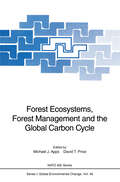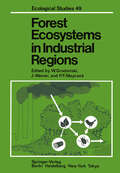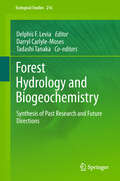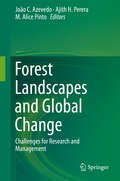- Table View
- List View
The Forest-Atmosphere Interaction: Proceedings of the Forest Environmental Measurements Conference held at Oak Ridge, Tennessee, October 23–28, 1983
by B. A. Hutchison B. B. HicksThe effects of meteorological phenomena upon forest produc tivity and forestry operations have been of concern for many years. With the evolution of system-level studies of forest eco system structure and function in the International Biological Program and elsewhere, more fundamental interactions between forest ecosystems and the atmosphere received scientific atten tion but the emphasis on meteorological and climatological effects on forest processes remained. More recently, as recogni tion has developed of potential and actual problems associated with the atmospheric transport, dispersion, and deposition of airborne pollutants, the effects of forest canopies upon boundary-layer meteorological phenomena has come under scientific scrutiny. Looking to the future, with rising atmospheric con centrations of C02 and increasing competition for the finite fresh-water resources of the earth, interest in the role of forests in global C02 and water balances can also be expected to intensify. Thus, the nature of forest canopy-atmosphere interac tions, that is to say, the meteorological phenomena occurring in and above forest canopies, are of importance to a wide variety of scientific and social-issues. Demands for forest meteorological information currently exceed levels of knowledge and given the economic constraints of science in general and environmental sciences in particular, chances for major improvements in scien tific support in the near future are slim. Unfortunately, studies of environmental phenomena in and above forests are costly and logistically difficult. Trees, the ecological dominants of forest ecosystems, are the largest of all terrestrial organisms.
Forest Carbon Practices and Low Carbon Development in China
by Zhi Lu Xiaoquan Zhang Jian Ma Caifu TangThis is the first book illustrating China’s forest carbon projects. It includes an analysis of the policy and future development trends of China’s forest carbon market and showcases the country’s most representative forest carbon projects. Accordingly, it offers a valuable resource for all policymakers and researchers interested in forest carbon, as well as project developers and engineers involved in forest carbon projects.
Forest Certification: Roots, Issues, Challenges, and Benefits
by Anna Fanzeres John C. Gordon Bruce C. Larson Daniel J. VogtForest certification has been widely accepted as a tool that would encourage industrial and non-industrial management of resources in an environmentally acceptable, socially beneficial and economically viable manner. Much has been written on certification yet five issues have been missing, which this book addresses: an analysis of the scientific ba
Forest conservation in protected areas of Bangladesh: Policy and community development perspectives (World Forests #20)
by Mohammad Shaheed Hossain ChowdhuryThis book dealt with a number of issues under the broad subject matter of protected area focusing on the policy of collaborative management as a means to augment the forest conservation activities and enhance community development in Bangladesh. Studies covered in the book emerged with the success stories of protected area co-management, both in terms of community development and biodiversity conservation. Significant level of development was noticed in the socio-economic conditions of the surrounding communities. Empowerment and improved social dignity of women participants signifies the initiation of co-management approach. The principles of participatory governance were found reasonably well reflected in legal and policy frameworks. Based on the lessons from the studies, a general metaphysical model, namely ‘Spider-web model of protected area co-management’ has been developed that can be potentially applicable in countries where local communities rely heavily on protected areas.
Forest Decline and Atmospheric Deposition Effects in the French Mountains
by M. KaennelForest decline became a matter of public and scientific concern in France in 1983 when conifers in the Vosges mountains were found to exhibit unusual crown deterioration. An impassioned controversy on a supposedly large scale forest health problem was then in full swing in Central Europe. A co-ordinated research programme entitled DEFORPA ("Deperissement des For~ts et Pollution AtmospMrique") was launched in 1984. This programme ran from 1984 to 1991 and a number of projects are still in progress. The Programme was sponsored by three French ministries (Enviroument, Agriculture and Forestry, Research and Technologyl), several state agencies, various regional authorities and the Commission of the European Communities (DO xn and DG VI). Initially, emphasis was solely laid on the understanding of forest decline in the mountainous areas - because damage was most obvious there - in relation to natural and man-made factors. Air pollution was given high but not overwhelming priority. Thus, the DEFORPA Programme was not in its essence a nation-wide assessment of air pollution effects, unlike a number of national acidification research programmes in Europe and North America. During. the programme, however, the areas of concern expanded. In particular, research into water acidification in the Vosges mountains was developed in parallel with the DEFORPA Programme, and possible eutrophication of the ground flora in northeastern France became the subject of new research.
Forest Decline in the Atlantic and Pacific Region
by Reinhard F. Huettl Dieter Mueller-DomboisForest damage, forest decline, forest dieback - not related to biotic agents - is occurring in the Atlantic and Pacific regions. In Europe and Eastern North America this serious problem is considered to be, at least to some part, related to industrial air pollutants and their atmospheric conversion products, such as acid rain or ozone. Forest declines in the Pacific region have been attributed largely to natural causes involving forest dynamics, since air pollution and other negative anthropogenic influences are practically absent. Presented here are typical decline phenomena in the Pacific and Atlantic region, potential causes, effects and mitigation strategies, and the question whether there are any similarities on a functional or structural basis is addressed.
Forest Development: Succession, Environmental Stress and Forest Management Case Studies
by Achim Dohrenbusch and Norbert BartschForest ecosystems are characterized by a steady change in their structure of function. Natural developments are more and more radically disturbed by human impact. Air pollution leads to soil acidification, change in nutrient budget and to a decreasing vitality of the trees. Forest management can prevent natural succession and often leads to less stable forests. In this book, selected results of 10 years of interdisciplinary ecosystem research are presented. Not only growth and physiological reactions on environmental stress, but also natural succession processes are described and analysed. Besides the description of forest development processes, based on longterm experiments and observation, conclusions for practical forest management are given.
Forest Diversity and Function: Temperate and Boreal Systems (Ecological Studies #176)
by Michael Scherer-Lorenzen Christian Körner Ernst-Detlef SchulzeOne of the central research themes in ecology is evaluating the extent to which biological richness is necessary to sustain the Earth's system and the functioning of individual ecosystems. In this volume, for the first time, the relationship between biodiversity and ecosystem processes in forests is thoroughly explored. The text examines the multiple effects of tree diversity on productivity and growth, biogeochemical cycles, animals, pests, and disturbances. Further, the importance of diversity at different scales, ranging from stand management to global issues, is considered. The authors provide both extensive reviews of the existing literature and own datasets. The volume is ideally suited for researchers and practitioners involved in ecosystem management and the sustainable use of forest resources.
Forest Dynamics and Conservation: Science, Innovations and Policies
by Manoj Kumar Shalini Dhyani Naveen KalraThis book unveils forestry science and its policy and management that connect past and present understanding of forests. The aggregated knowledge is presented to cover the approaches adopted in studying forest structure, its growth, functioning, and degradation, especially in the context of the surrounding environment. The application of advance computation, instrumentation, and modelling has been elaborated in various chapters.Forest ecosystems are rapidly changing due to forest fires, deforestation, urbanization, climate change, and other natural and anthropogenic drivers. Understanding the dynamics of forest ecosystems requires contemporary methods and measures, utilizing modern tools and big data for developing effective conservation plans. The book also covers discussion on policies for sustainable forestry, agroforestry, environmental governance, socio-ecology, nature-based solutions, and management implication. It is suitable for a wide range of readers working in the field of scientific forestry, policy making, and forest management. In addition, it is a useful material for postgraduate and research students of forestry sciences.
Forest Ecosystems
by Ram Oren David A. Perry Stephen C. HartThis acclaimed textbook is the most comprehensive available in the field of forest ecology. Designed for advanced students of forest science, ecology, and environmental studies, it is also an essential reference for forest ecologists, foresters, and land managers. The authors provide an inclusive survey of boreal, temperate, and tropical forests with an emphasis on ecological concepts across scales that range from global to landscape to microscopic. Situating forests in the context of larger landscapes, they reveal the complex patterns and processes observed in tree-dominated habitats. The updated and expanded second edition covers • Conservation• Ecosystem services • Climate change• Vegetation classification• Disturbance• Species interactions• Self-thinning• Genetics• Soil influences• Productivity• Biogeochemical cycling• Mineralization• Effects of herbivory• Ecosystem stability
Forest Ecosystems and Environments: Scaling Up from Shoot Module to Watershed
by Takashi Kohyama Josep Canadell Dennis S. Ojima Louis F. PitelkaCoastal East and Southeast Asia are characterized by wet growing seasons, and species-rich forest ecosystems develop throughout the latitudinal and altitudinal gradients. In this region, the Global Change Impacts on Terrestrial Ecosystems in Monsoon Asia (TEMA) project was carried out as a unique contribution to the international project Global Change and Terrestrial Ecosystems. TEMA aimed to integrate forest ecosystem processes, from leaf physiology to meteorological budget and prediction of long-term change of vegetation composition and architecture through demographic processes. Special attention was given to watershed processes, where forest ecosystem metabolism affects the properties and biogeochemical budgets of freshwater ecosystems, and where rivers, wetlands, and lakes are subject to direct and indirect effects of environmental change. This volume presents the scaling-up concept for better understanding of ecosystem functioning.
Forest Ecosystems, Forest Management and the Global Carbon Cycle (Nato ASI Subseries I: #40)
by Michael J. Apps David T. PriceGlobally, forest vegetation and soils are both major stores of terrestrial organic carbon, and major contributors to the annual cycling of carbon between the atmosphere and the biosphere. Forests are also a renewable resource, vital to the everyday existence of millions of people, since they provide food, shelter, fuel, raw materials and many other benefits. The combined effects of an expanding global population and increasing consumption of resources, however, may be seriously endangering both the extent and future sustainability of the world's forests. About thirty chapters cover four main themes: the role of forests in the global carbon cycle; effects of past, present and future changes in forest land use; the role of forest management, products and biomass on carbon cycling, and socio-economic impacts.
Forest Ecosystems in Industrial Regions: Studies on the Cycling of Energy Nutrients and Pollutants in the Niepo?omice Forest Southern Poland (Ecological Studies #49)
by W. Grodzinski J Weiner P. MaycockA number of well-known forests have been the object of studies by ecological teams. Every ecologist is familiar with the names of forests such as Whytham Woods in England (Elton 1966), Solling in West Germany (Ellenberg 1971), Hubbard Brook in New Hampshire, U. S. A. (Likens et al. 1977, Bormann and Likens 1979), and ladra6s in Central Sweden (Persson 1980). The number of such team studies grew rapidly during the period of the International Biological Programme (Reichle 1981). Each of these forests represented aspects oflocal and general interest. The Niepolomice Forest in Southern Poland (Fig. 1) does not possess any spectacular features and it may be regarded as a typical forest of the lowlands of continental Europe. Situated in the Vistula River Valley, 20 km east of Cracow (50°07' N, 20°23' E) it consists of two major sections: an extensive pine forest of the Pino-Quercetum type, and a smaller, deciduous, oak-hornbeam- Fig. 1. The location of the Niepolomice Forest in Southern Poland VI Preface Tilio Carpinetum forest. This huge forested area (11,000 ha) owes its survival in one of the most densely populated parts of Europe to a long period of protection as a royal hunting ground. The period of royal protection ended abruptly at the turn of 20th century under the devastating blows of two world wars followed by perhaps an even greater danger, the effects of modern developments in heavy industry.
The Forest Frontier: Settlement and Change in Brazilian Roraima
by Edited by Peter A. FurleyDestructive patterns of Amazonian evolution are now infecting relatively untouched Northern Brazil - driven by the gold rush and demographic and economic forces from the South. The Forest Frontier assesses whether the Northern Amazonian States can avoid the same pressures and problems that affect the peoples and environments of the South. It examines the social and environmental nature of land development in Roraima, the most northerly of the Brazilian Amazonian states. Possessing most of the classic problems facing other States as well as containing a combination of political, cultural and environmental features, Roraima's development is at a frontier. Offering a critical assessment of the nature and pace of agricultural advance into Roraima, The Forest Frontier will provide a better understanding to plan for the inevitable development to come.
The Forest Frontier: Settlement and Change in Brazilian Roraima
by Peter A. FurleyDestructive patterns of Amazonian evolution are now infecting relatively untouched Northern Brazil - driven by the gold rush and demographic and economic forces from the South. The Forest Frontier assesses whether the Northern Amazonian States can avoid the same pressures and problems that affect the peoples and environments of the South. It examines the social and environmental nature of land development in Roraima, the most northerly of the Brazilian Amazonian states. Possessing most of the classic problems facing other States as well as containing a combination of political, cultural and environmental features, Roraima's development is at a frontier. Offering a critical assessment of the nature and pace of agricultural advance into Roraima, The Forest Frontier will provide a better understanding to plan for the inevitable development to come.
The Forest Frontier: Settlement and Change in Brazilian Roraima (Routledge Library Editions: Forestry)
by Peter A. FurleyOriginally published in 1994, this book analysed land developments, deforestation and pasture substitution, colonisation schemes and spontaneous settlement during the latter part of the 20th Century. In so doing, The Forest Frontier presents an overview of the intrinsic environmental and socio-economic resources of the Roraima, the most northerly of the Brazilian Amazon states. Roraima is of special environmental interest because of its extensive savannas and varied forests – the home of some of the largest and most diverse groups of indigenous Indians. This critical assessment of the nature and pace of agricultural advance into Roraima examines the range of strategies which have been proposed to cope with the inevitable development. With the conflict between preserving the natural environment and development still major issues for Brazil, this book remains as relevant now as when it was first published.
The Forest Frontier: Settlement and Change in Brazilian Roraima (Routledge Library Editions: Forestry)
Originally published in 1994, this book analysed land developments, deforestation and pasture substitution, colonisation schemes and spontaneous settlement during the latter part of the 20th Century. In so doing, The Forest Frontier presents an overview of the intrinsic environmental and socio-economic resources of the Roraima, the most northerly of the Brazilian Amazon states. Roraima is of special environmental interest because of its extensive savannas and varied forests – the home of some of the largest and most diverse groups of indigenous Indians. This critical assessment of the nature and pace of agricultural advance into Roraima examines the range of strategies which have been proposed to cope with the inevitable development. With the conflict between preserving the natural environment and development still major issues for Brazil, this book remains as relevant now as when it was first published.
Forest Genetics and Sustainability (Forestry Sciences #63)
by Csaba MátyásDuring the 4th International Consultation on Forest Genetics and Tree Building, held in 1998 in Beijing, China, leading scientists were invited to review past achievements, to redefine the role of forest genetics and breeding in contemporary forestry, and to set priorities for future research and development. On the basis of the invited presentations, the volume summarizes the state of knowledge in various fields, such as the impact of forest management and of changing environmental conditions on genetic resources, and the value of genetic markers as indicators for adaptational potential, as well as the tasks of conservation. Detailed reports from the different continents provide a comprehensive diagnosis of the global situation of forest genetics and tree breeding research. The book offers not only an overview of contemporary trends and expected future developments, but also identifies current main problems in funding and cooperation. It may prove therefore useful not only for scientists, university lecturers and advanced students in the field of forestry, ecology and conservation biology, but also for decision makers and managers in companies and conservation organizations.
Forest Hydrology and Biogeochemistry: Synthesis of Past Research and Future Directions (Ecological Studies #216)
by Delphis F. Levia, Darryl Carlyle-Moses and Tadashi TanakaThis international rigorously peer-reviewed volume critically synthesizes current knowledge in forest hydrology and biogeochemistry. It is a one-stop comprehensive reference tool for researchers and practitioners in the fields of hydrology, biogeoscience, ecology, forestry, boundary-layer meteorology, and geography. Following an introductory chapter tracing the historical roots of the subject, the book is divided into the following main sections:· Sampling and Novel Approaches· Forest Hydrology and Biogeochemistry by Ecoregion and Forest Type· Hydrologic and Biogeochemical Fluxes from the Canopy to the Phreatic Surface· Hydrologic and Biogeochemical Fluxes in Forest Ecosystems: Effects of Time, Stressors, and HumansThe volume concludes with a final chapter that reflects on the current state of knowledge and identifies some areas in need of further research.
Forest Hydrology and Catchment Management: An Australian Perspective
by Leon BrenFor the last three centuries forests have been recognised as providing the best water catchments and valued for their sustained output of high quality water. In Australia, work which was commenced fifty years ago has come to fruition and is providing new information on forest hydrology issues. The book focusses on the issues of small streams, including catchment definition, slope, hydrograph formation, water quality measurement, and annual water yield. The world-wide management issues of sustaining riparian forests are examined, using the River Murray forests as an example. Finally a large amount of information is drawn together to examine the management of forested catchments for water supplies. This book presents an incisive, disciplined, quantitative approach to dealing with forest hydrology matters. Although world-wide in application, the book particularly draws on Australian studies. It is written with the needs of students and forest practitioners in mind.
Forest Hydrology and Catchment Management: An Australian Perspective
by Leon BrenThis book provides scientific evidence to underline the notion that forests offer the most reliable water catchments in the natural environment. The unique Australian ecosystem provides valuable information on the water yields and hydro-ecology of forests. Insights can be transferred to other climate zones and conditions. In this second edition, the author puts a particular focus on the most prominent challenges of our time, in relation to water management. Ground salinity, climate change, and droughts have all been newly added to this updated edition. One of the most important concepts is highlighting the accumulated contribution of smaller catchments and minor streams. Finally, readers will also get information on the economic dimension of water management. With its incisive, disciplined, and quantitative (and occasionally humorous) approach, this book helps scientists, students, and regulators to understand water-driven conflicts and offers guidance on management.
Forest Hydrology and Ecology at Coweeta (Ecological Studies #66)
by Wayne T. Swank D. A. Jr. CrossleyCoweeta is one of the oldest continuously operating laboratories of its type in the world. For the first time, a complete review and summary of more than 50 years study of the hydrological and ecological responses of baseline and managed Southern Appalachian hardwood forests at Coweeta is now supplied by this volume. The long-term research approach represents a continuum of theory, experimentation and application using watersheds as landscape units of investigation. Thus, the information encompasses a wide range of interpretations and interests. In addition to in-depth analyses of terrestrial and stream processes, the breadth of coverage includes historical perspectives and relevance of ecosystem science to management needs. In a broader sense, the Coweeta research effort is considered from a perspective of national and international forest hydrology and ecology programs.
Forest Insects in Europe: Diversity, Functions and Importance
by Beat WermelingerForest insects play important roles ecologically and economically. They pollinate plants, decompose dead plant and animal tissue, provide food for vertebrates, regulate pest organisms and shape entire landscapes. Some are considered pests, while others provide usable products. Introduced species may become invasive, while the survival of others is threatened. Forest Insects in Europe: Diversity, Functions and Importance has been written not only with professional entomologists in mind, but also for nature lovers generally. The descriptions of the various roles insects play in forest ecosystems are intended to be easily comprehensible, but still scientific. The book is richly illustrated with attractive photos and contains 580 fascinating colour images of more than 300 different insect and spider species. The German edition was awarded the Prix Moulines by the Swiss Entomological Society in 2019.
Forest Insects in Europe: Diversity, Functions and Importance
by Beat WermelingerForest insects play important roles ecologically and economically. They pollinate plants, decompose dead plant and animal tissue, provide food for vertebrates, regulate pest organisms and shape entire landscapes. Some are considered pests, while others provide usable products. Introduced species may become invasive, while the survival of others is threatened. Forest Insects in Europe: Diversity, Functions and Importance has been written not only with professional entomologists in mind, but also for nature lovers generally. The descriptions of the various roles insects play in forest ecosystems are intended to be easily comprehensible, but still scientific. The book is richly illustrated with attractive photos and contains 580 fascinating colour images of more than 300 different insect and spider species. The German edition was awarded the Prix Moulines by the Swiss Entomological Society in 2019.
Forest Landscapes and Global Change: Challenges for Research and Management
by João C. Azevedo Ajith H. Perera M. Alice PintoClimate change, urban sprawl, abandonment of agriculture, intensification of forestry and agriculture, changes in energy generation and use, expansion of infrastructure networks, habitat destruction and degradation, and other drivers of change occur at increasing rates. They affect patterns and processes in forest landscapes, and modify ecosystem services derived from those ecosystems. Consequently, rapidly changing landscapes present many new challenges to scientists and managers. While it is not uncommon to encounter the terms “global change” and “landscape” together in the ecological literature, a global analyses of drivers of change in forest landscapes, and their ecological consequences have not been addressed adequately. That is the goal of this volume: an exploration of the state of knowledge of global changes in forested landscapes with emphasis on causes and effects, and challenges faced by researchers and land managers. Initial chapters identify and describe major agents of landscape change: climate, fire, and human activities. The next series of chapters address implications of changes on ecosystem services, biodiversity conservation and carbon flux. A chapter that describes methodologies of detecting and monitoring landscape changes is presented followed by chapter that highlights the many challenges forest landscape managers face amidst of global change. Finally, we present a summary and a synthesis of the main points presented in the book. Each chapter will contain the individual research experiences of chapter authors, augmented by review and synthesis of global scientific literature on relevant topics, as well as critical input from multiple peer reviewers.





















